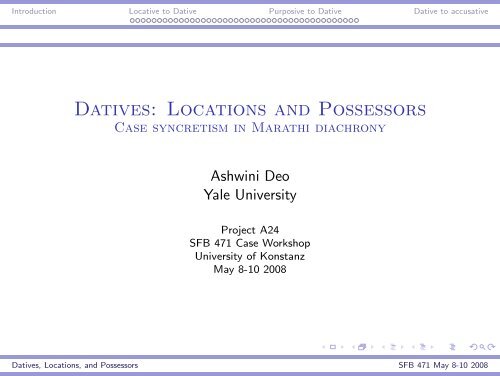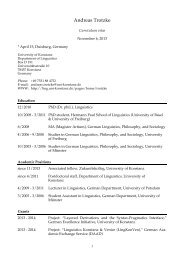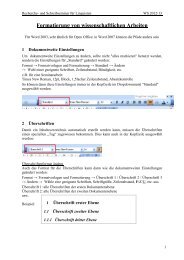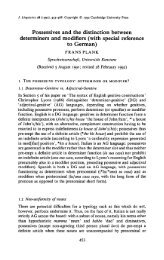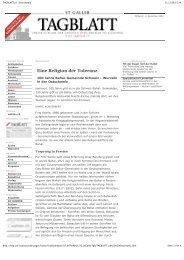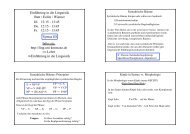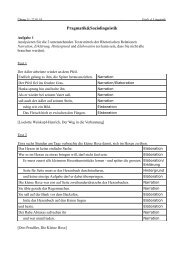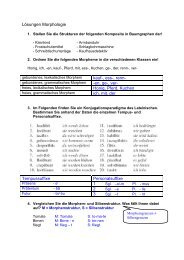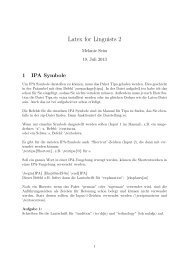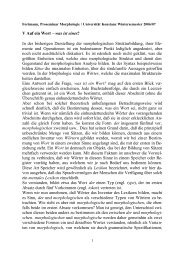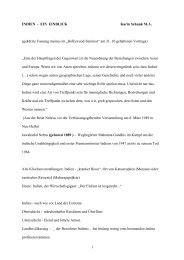Datives: Locations and Possessors Case syncretism in Marathi ...
Datives: Locations and Possessors Case syncretism in Marathi ...
Datives: Locations and Possessors Case syncretism in Marathi ...
Create successful ePaper yourself
Turn your PDF publications into a flip-book with our unique Google optimized e-Paper software.
Introduction Locative to Dative Purposive to Dative Dative to accusative<br />
<strong>Datives</strong>: <strong>Locations</strong> <strong>and</strong> <strong>Possessors</strong><br />
<strong>Case</strong> <strong>syncretism</strong> <strong>in</strong> <strong>Marathi</strong> diachrony<br />
Ashw<strong>in</strong>i Deo<br />
Yale University<br />
Project A24<br />
SFB 471 <strong>Case</strong> Workshop<br />
University of Konstanz<br />
May 8-10 2008<br />
<strong>Datives</strong>, <strong>Locations</strong>, <strong>and</strong> <strong>Possessors</strong> SFB 471 May 8-10 2008
Introduction Locative to Dative Purposive to Dative Dative to accusative<br />
Outl<strong>in</strong>e<br />
Introduction<br />
Locative to Dative<br />
Old <strong>Marathi</strong><br />
The dative doma<strong>in</strong><br />
Modern <strong>Marathi</strong><br />
The trajectory<br />
Purposive to Dative<br />
Dative to accusative<br />
<strong>Datives</strong>, <strong>Locations</strong>, <strong>and</strong> <strong>Possessors</strong> SFB 471 May 8-10 2008
Introduction Locative to Dative Purposive to Dative Dative to accusative<br />
<strong>Locations</strong> <strong>and</strong> datives<br />
The localist hypothesis posits that notions of location <strong>in</strong> space <strong>and</strong><br />
motion are central to the conceptualization of all other relations.<br />
<strong>Datives</strong>, <strong>Locations</strong>, <strong>and</strong> <strong>Possessors</strong> SFB 471 May 8-10 2008
Introduction Locative to Dative Purposive to Dative Dative to accusative<br />
<strong>Locations</strong> <strong>and</strong> datives<br />
The localist hypothesis posits that notions of location <strong>in</strong> space <strong>and</strong><br />
motion are central to the conceptualization of all other relations.<br />
◮ <strong>Possessors</strong> are animate locations (Aristar 1996).<br />
<strong>Datives</strong>, <strong>Locations</strong>, <strong>and</strong> <strong>Possessors</strong> SFB 471 May 8-10 2008
Introduction Locative to Dative Purposive to Dative Dative to accusative<br />
<strong>Locations</strong> <strong>and</strong> datives<br />
The localist hypothesis posits that notions of location <strong>in</strong> space <strong>and</strong><br />
motion are central to the conceptualization of all other relations.<br />
◮ <strong>Possessors</strong> are animate locations (Aristar 1996).<br />
◮ Recipients/benefactives are abstract goals. (Gruber 1965;<br />
Jackendoff 1972, 1983)<br />
<strong>Datives</strong>, <strong>Locations</strong>, <strong>and</strong> <strong>Possessors</strong> SFB 471 May 8-10 2008
Introduction Locative to Dative Purposive to Dative Dative to accusative<br />
<strong>Locations</strong> <strong>and</strong> datives<br />
The localist hypothesis posits that notions of location <strong>in</strong> space <strong>and</strong><br />
motion are central to the conceptualization of all other relations.<br />
◮ <strong>Possessors</strong> are animate locations (Aristar 1996).<br />
◮ Recipients/benefactives are abstract goals. (Gruber 1965;<br />
Jackendoff 1972, 1983)<br />
◮ Experiencers are goals/locations. (Br<strong>and</strong>t 2003; L<strong>and</strong>au 2005)<br />
<strong>Datives</strong>, <strong>Locations</strong>, <strong>and</strong> <strong>Possessors</strong> SFB 471 May 8-10 2008
Introduction Locative to Dative Purposive to Dative Dative to accusative<br />
<strong>Locations</strong> <strong>and</strong> datives<br />
The localist hypothesis posits that notions of location <strong>in</strong> space <strong>and</strong><br />
motion are central to the conceptualization of all other relations.<br />
◮ <strong>Possessors</strong> are animate locations (Aristar 1996).<br />
◮ Recipients/benefactives are abstract goals. (Gruber 1965;<br />
Jackendoff 1972, 1983)<br />
◮ Experiencers are goals/locations. (Br<strong>and</strong>t 2003; L<strong>and</strong>au 2005)<br />
At least some part of the motivation for the localist hypothesis<br />
comes from the common l<strong>in</strong>guistic encod<strong>in</strong>g for locations,<br />
possessors, recipients, benefactives, <strong>and</strong> experiencers<br />
crossl<strong>in</strong>guistically.<br />
<strong>Datives</strong>, <strong>Locations</strong>, <strong>and</strong> <strong>Possessors</strong> SFB 471 May 8-10 2008
Introduction Locative to Dative Purposive to Dative Dative to accusative<br />
<strong>Locations</strong> <strong>and</strong> datives<br />
The localist hypothesis posits that notions of location <strong>in</strong> space <strong>and</strong><br />
motion are central to the conceptualization of all other relations.<br />
◮ <strong>Possessors</strong> are animate locations (Aristar 1996).<br />
◮ Recipients/benefactives are abstract goals. (Gruber 1965;<br />
Jackendoff 1972, 1983)<br />
◮ Experiencers are goals/locations. (Br<strong>and</strong>t 2003; L<strong>and</strong>au 2005)<br />
At least some part of the motivation for the localist hypothesis<br />
comes from the common l<strong>in</strong>guistic encod<strong>in</strong>g for locations,<br />
possessors, recipients, benefactives, <strong>and</strong> experiencers<br />
crossl<strong>in</strong>guistically.<br />
e.g. Dative mark<strong>in</strong>g, prepositions like to, á...<br />
<strong>Datives</strong>, <strong>Locations</strong>, <strong>and</strong> <strong>Possessors</strong> SFB 471 May 8-10 2008
Introduction Locative to Dative Purposive to Dative Dative to accusative<br />
<strong>Locations</strong> <strong>and</strong> datives<br />
Dative mark<strong>in</strong>g (<strong>in</strong>flectional cases, case clitics, adpositions)<br />
provides the start<strong>in</strong>g po<strong>in</strong>t for determ<strong>in</strong><strong>in</strong>g the relation between<br />
locations <strong>and</strong> the other categories.<br />
Three logical possibilities<br />
◮ Rampant homophony<br />
◮ <strong>Possessors</strong>, recipients, benefactive, experiencers are locations.<br />
◮ Some unified abstract category exists that subsumes these <strong>and</strong><br />
locations.<br />
<strong>Datives</strong>, <strong>Locations</strong>, <strong>and</strong> <strong>Possessors</strong> SFB 471 May 8-10 2008
Introduction Locative to Dative Purposive to Dative Dative to accusative<br />
The semantic relation<br />
direction<br />
purpose<br />
predicative possessor external possessor<br />
recipient<br />
experiencer<br />
(Based on Haspelmath 2003 (pp.213), Fig,. 8.1.)<br />
beneficiary<br />
<strong>Datives</strong>, <strong>Locations</strong>, <strong>and</strong> <strong>Possessors</strong> SFB 471 May 8-10 2008
Introduction Locative to Dative Purposive to Dative Dative to accusative<br />
The semantic relation<br />
direction<br />
purpose<br />
predicative possessor external possessor<br />
recipient<br />
experiencer<br />
beneficiary<br />
<strong>Datives</strong>, <strong>Locations</strong>, <strong>and</strong> <strong>Possessors</strong> SFB 471 May 8-10 2008
Introduction Locative to Dative Purposive to Dative Dative to accusative<br />
The semantic relation<br />
direction<br />
purpose<br />
predicative possessor external possessor<br />
recipient<br />
experiencer<br />
beneficiary<br />
a. John went to Konstanz. direction<br />
b. John went to get a pen. purpose<br />
c. John gave a pen to Maria. recipient<br />
d. It seems absurd to John. experiencer<br />
<strong>Datives</strong>, <strong>Locations</strong>, <strong>and</strong> <strong>Possessors</strong> SFB 471 May 8-10 2008
Introduction Locative to Dative Purposive to Dative Dative to accusative<br />
Semantic maps (Haspelmath 2003)<br />
◮ Multifunctionality: a result of ambiguity or vagueness?<br />
◮ Recurrent patterns <strong>in</strong> distribution of l<strong>in</strong>guistic units across<br />
languages.<br />
◮ The work done by the connect<strong>in</strong>g l<strong>in</strong>es is to impose<br />
restrictions on the cluster<strong>in</strong>gs of mean<strong>in</strong>gs. (the<br />
“arrangement” of functions).<br />
◮ L<strong>in</strong>guistic units express contiguous sub-sets of such functions.<br />
◮ Other terms<br />
◮ Conceptual Space Croft (2001)<br />
◮ Mental map (Anderson 1986)<br />
◮ Cognitive map (Kortmann 1997)<br />
◮ Implicational map (Haspelmath 1997)<br />
<strong>Datives</strong>, <strong>Locations</strong>, <strong>and</strong> <strong>Possessors</strong> SFB 471 May 8-10 2008
Introduction Locative to Dative Purposive to Dative Dative to accusative<br />
Some historical <strong>and</strong> typological questions<br />
◮ What is the morphological source of dative mark<strong>in</strong>g?<br />
◮ At least some cases where they come from locatives<br />
(Kurylowicz 1964; Aristar 1996)<br />
◮ At least some cases where they come from<br />
purposives/benefactives (<strong>Marathi</strong>)<br />
<strong>Datives</strong>, <strong>Locations</strong>, <strong>and</strong> <strong>Possessors</strong> SFB 471 May 8-10 2008
Introduction Locative to Dative Purposive to Dative Dative to accusative<br />
Some historical <strong>and</strong> typological questions<br />
◮ What is the morphological source of dative mark<strong>in</strong>g?<br />
◮ At least some cases where they come from locatives<br />
(Kurylowicz 1964; Aristar 1996)<br />
◮ At least some cases where they come from<br />
purposives/benefactives (<strong>Marathi</strong>)<br />
◮ How is the path to dative mark<strong>in</strong>g effected (or what does it<br />
mean for datives to “come from” locatives or benefactives)?<br />
◮ Locative ≫ Dative<br />
◮ Benefactive ≫ Dative<br />
<strong>Datives</strong>, <strong>Locations</strong>, <strong>and</strong> <strong>Possessors</strong> SFB 471 May 8-10 2008
Introduction Locative to Dative Purposive to Dative Dative to accusative<br />
Some historical <strong>and</strong> typological questions<br />
◮ What is the morphological source of dative mark<strong>in</strong>g?<br />
◮ At least some cases where they come from locatives<br />
(Kurylowicz 1964; Aristar 1996)<br />
◮ At least some cases where they come from<br />
purposives/benefactives (<strong>Marathi</strong>)<br />
◮ How is the path to dative mark<strong>in</strong>g effected (or what does it<br />
mean for datives to “come from” locatives or benefactives)?<br />
◮ Locative ≫ Dative<br />
◮ Benefactive ≫ Dative<br />
◮ What are the shared semantic properties of the categories that<br />
get realized with dative mark<strong>in</strong>g?<br />
◮ What properties make a particular exponent a dative marker?<br />
<strong>Datives</strong>, <strong>Locations</strong>, <strong>and</strong> <strong>Possessors</strong> SFB 471 May 8-10 2008
Introduction Locative to Dative Purposive to Dative Dative to accusative<br />
The relevant contexts of use:<br />
a. The lamp is to the edge of the table. static locative<br />
b. John walked to the corner. allative<br />
c. *To Maria is a pen/a car/a kitchen. possession-alienable<br />
d. *To Maria is a sister/a nose/pride. possession-<strong>in</strong>alienable<br />
e. *To Maria is fear/worry/a headache experiencer<br />
f. John gave the pen to Maria. recipient<br />
g. John sent the children to Maria. goal<br />
h. John baked a cake for Maria. beneficiary<br />
i. John came to the house for his keys. purpose<br />
<strong>Datives</strong>, <strong>Locations</strong>, <strong>and</strong> <strong>Possessors</strong> SFB 471 May 8-10 2008
Introduction Locative to Dative Purposive to Dative Dative to accusative<br />
The relevant contexts of use:<br />
a. The lamp is to the edge of the table. static locative<br />
b. John walked to the corner. allative<br />
c. *To Maria is a pen/a car/a kitchen. possession-alienable<br />
d. *To Maria is a sister/a nose/pride. possession-<strong>in</strong>alienable<br />
e. *To Maria is fear/worry/a headache experiencer<br />
f. John gave the pen to Maria. recipient<br />
g. John sent the children to Maria. goal<br />
h. John baked a cake for Maria. beneficiary<br />
i. John came to the house for his keys. purpose<br />
Which subsets of these contexts appear with dative mark<strong>in</strong>g across<br />
grammars?<br />
What does this depend on?<br />
<strong>Datives</strong>, <strong>Locations</strong>, <strong>and</strong> <strong>Possessors</strong> SFB 471 May 8-10 2008
Introduction Locative to Dative Purposive to Dative Dative to accusative<br />
A further twist: the accusative<br />
◮ Most Indic languages have DOM determ<strong>in</strong>ed by animacy <strong>and</strong><br />
def<strong>in</strong>iteness.<br />
◮ There is no dist<strong>in</strong>ct accusative marker (at least <strong>in</strong> the<br />
well-studied languages); the dative gets employed <strong>in</strong> this use.<br />
◮ Is this a phenomenon that (at least partially) needs a<br />
diachronic account?<br />
<strong>Datives</strong>, <strong>Locations</strong>, <strong>and</strong> <strong>Possessors</strong> SFB 471 May 8-10 2008
Introduction Locative to Dative Purposive to Dative Dative to accusative<br />
A further twist: the accusative<br />
◮ Most Indic languages have DOM determ<strong>in</strong>ed by animacy <strong>and</strong><br />
def<strong>in</strong>iteness.<br />
◮ There is no dist<strong>in</strong>ct accusative marker (at least <strong>in</strong> the<br />
well-studied languages); the dative gets employed <strong>in</strong> this use.<br />
◮ Is this a phenomenon that (at least partially) needs a<br />
diachronic account?<br />
◮ Evidence from <strong>Marathi</strong> does seem to suggest that the dative<br />
gets diachronically extended to accusative contexts (despite<br />
the presence of a morphologically dist<strong>in</strong>ct accusative marker).<br />
<strong>Datives</strong>, <strong>Locations</strong>, <strong>and</strong> <strong>Possessors</strong> SFB 471 May 8-10 2008
Introduction Locative to Dative Purposive to Dative Dative to accusative<br />
The morphological trajectory(ies)<br />
A set of morphological functional changes <strong>in</strong> need of an<br />
explanation...<br />
Purposive Locative<br />
Dative<br />
Accusative<br />
<strong>Datives</strong>, <strong>Locations</strong>, <strong>and</strong> <strong>Possessors</strong> SFB 471 May 8-10 2008
Introduction Locative to Dative Purposive to Dative Dative to accusative<br />
Goals of this talk<br />
◮ Present historical <strong>and</strong> synchronic data from <strong>Marathi</strong> to<br />
determ<strong>in</strong>e what a plausible path of change for some<br />
adpositional/case markers could be.<br />
◮ Extrapolate from this to determ<strong>in</strong>e what a plausible “semantic<br />
map” of these related categories could be.<br />
◮ Hypothesize what diachronic processes might be <strong>in</strong>volved <strong>in</strong><br />
the change (semantic generalization, pragmatic enrichment,<br />
etc...)<br />
<strong>Datives</strong>, <strong>Locations</strong>, <strong>and</strong> <strong>Possessors</strong> SFB 471 May 8-10 2008
Introduction Locative to Dative Purposive to Dative Dative to accusative<br />
In a nutshell: <strong>Datives</strong> across <strong>Marathi</strong> grammar<br />
◮ A dative that (is said to) have its source <strong>in</strong> a locative<br />
adposition.<br />
◮ A dative that has its source <strong>in</strong> a purposive adposition.<br />
◮ An accusative with marg<strong>in</strong>al dative functions that is traceable<br />
to a purposive adposition.<br />
◮ The non-locative <strong>and</strong> non-purposive uses of locative <strong>and</strong><br />
purposive adpositions.<br />
<strong>Datives</strong>, <strong>Locations</strong>, <strong>and</strong> <strong>Possessors</strong> SFB 471 May 8-10 2008
Introduction Locative to Dative Purposive to Dative Dative to accusative<br />
Outl<strong>in</strong>e<br />
Introduction<br />
Locative to Dative<br />
Old <strong>Marathi</strong><br />
The dative doma<strong>in</strong><br />
Modern <strong>Marathi</strong><br />
The trajectory<br />
Purposive to Dative<br />
Dative to accusative<br />
<strong>Datives</strong>, <strong>Locations</strong>, <strong>and</strong> <strong>Possessors</strong> SFB 471 May 8-10 2008
Introduction Locative to Dative Purposive to Dative Dative to accusative<br />
Old <strong>Marathi</strong><br />
Old <strong>Marathi</strong> case mark<strong>in</strong>g<br />
◮ Contrast between direct <strong>and</strong> oblique case<br />
◮ A dist<strong>in</strong>ct ‘accusative’ case-clitic -t e (conditioned by animacy<br />
<strong>and</strong> specificity)<br />
◮ A locative-dative case clitic -si with both static <strong>and</strong> allative<br />
uses.<br />
◮ A number of other locative postpositions, e.g. jawal.a ‘near’,<br />
pāsi ‘near’, ātu ‘<strong>in</strong>side’, khāle ‘below’ etc.<br />
◮ Two purposive adpositions -lāgī ‘regard<strong>in</strong>g’ <strong>and</strong> sāt.hī ‘for’.<br />
<strong>Datives</strong>, <strong>Locations</strong>, <strong>and</strong> <strong>Possessors</strong> SFB 471 May 8-10 2008
Introduction Locative to Dative Purposive to Dative Dative to accusative<br />
Old <strong>Marathi</strong><br />
The case-clitic -si<br />
◮ -si appears as a locative-dative marker <strong>in</strong> Old <strong>Marathi</strong> <strong>and</strong> is<br />
traced back to the Sanskrit locative forms a´sra ‘side’.<br />
◮ At the Old <strong>Marathi</strong> stage, it has the follow<strong>in</strong>g dative-like uses:<br />
◮ Spatial: co<strong>in</strong>cidence at location, goals<br />
◮ Possession: control, part-whole, k<strong>in</strong>ship, recipients<br />
◮ Other: experiencers, purposes, beneficiaries<br />
<strong>Datives</strong>, <strong>Locations</strong>, <strong>and</strong> <strong>Possessors</strong> SFB 471 May 8-10 2008
Introduction Locative to Dative Purposive to Dative Dative to accusative<br />
Old <strong>Marathi</strong><br />
The Dative: static locative use<br />
(1) gosāvī Dvārāvatie-si<br />
G.nom D-dat<br />
zhād.i-ti<br />
sweep-impf.3.pl<br />
kharāt.e-vari bīdī<br />
broom-with road.nom<br />
The Gosāvī, while at Dvārāvati, would sweep the roads with a<br />
broom (LC:E:2).<br />
<strong>Datives</strong>, <strong>Locations</strong>, <strong>and</strong> <strong>Possessors</strong> SFB 471 May 8-10 2008
Introduction Locative to Dative Purposive to Dative Dative to accusative<br />
Old <strong>Marathi</strong><br />
The Dative: static locative use<br />
(1) gosāvī Dvārāvatie-si<br />
G.nom D-dat<br />
zhād.i-ti<br />
sweep-impf.3.pl<br />
kharāt.e-vari bīdī<br />
broom-with road.nom<br />
The Gosāvī, while at Dvārāvati, would sweep the roads with a<br />
broom (LC:E:2).<br />
(2) tava gosāvīyā-si ekā sīl.ātal.ā-si āsan<br />
then G.-dat one.obl stone-dat seat.nom<br />
At that time, the Gosāvī had his seat at a stone. (LC:E:40)<br />
<strong>Datives</strong>, <strong>Locations</strong>, <strong>and</strong> <strong>Possessors</strong> SFB 471 May 8-10 2008
Introduction Locative to Dative Purposive to Dative Dative to accusative<br />
Old <strong>Marathi</strong><br />
The Dative: Allative use<br />
(3) mag kram˜e-kram˜e pratisthānā-si bīj˜e k˜e-l˜e.<br />
then, <strong>in</strong> sequence, P-dat<br />
bhogāvatie-si rāhi-le<br />
go-perf.3.n.sg B-dat live-perf.3.m.pl<br />
Then, gradually, they went to Pratisthāna. (On the way), they<br />
stayed at Bhogāvati. (LC:E:75).<br />
<strong>Datives</strong>, <strong>Locations</strong>, <strong>and</strong> <strong>Possessors</strong> SFB 471 May 8-10 2008
Introduction Locative to Dative Purposive to Dative Dative to accusative<br />
Old <strong>Marathi</strong><br />
The Dative: Allative use<br />
(4) dvārāvatī-ye gu ˙mpha-si ge-līy˜e tava teth˜e eku<br />
D.loc cave-dat go-perf.1.sg then there one<br />
mahātme ho-te<br />
great.soul.nom be.pst-3-pl<br />
(When) I went to the cave <strong>in</strong> Dvārāvati, there was a sa<strong>in</strong>t<br />
(great-souled one) there. (LC:E:4)<br />
<strong>Datives</strong>, <strong>Locations</strong>, <strong>and</strong> <strong>Possessors</strong> SFB 471 May 8-10 2008
Introduction Locative to Dative Purposive to Dative Dative to accusative<br />
Old <strong>Marathi</strong><br />
The Dative: Alienable possession (Control)<br />
(5) ān.i vāyū-sī... bid.hāra jaise nāhī ˙m<br />
And w<strong>in</strong>d-dat dwell<strong>in</strong>g as neg-pres.3.sg<br />
And just as the w<strong>in</strong>d does not have a dwell<strong>in</strong>g (<strong>in</strong> one place)...<br />
(Dny. 12: 221)<br />
(6) teyān-ce mat.hāpatye pustak bhān.d.ār teyā-si<br />
their<br />
jā-le<br />
monastery.wealth book-library he-dat<br />
become-perf.3.n.sg<br />
Their wealth <strong>and</strong> library of books became his.(LC:E:52)<br />
<strong>Datives</strong>, <strong>Locations</strong>, <strong>and</strong> <strong>Possessors</strong> SFB 471 May 8-10 2008
Introduction Locative to Dative Purposive to Dative Dative to accusative<br />
Old <strong>Marathi</strong><br />
The Dative: Inalienable possession (Part-Whole)<br />
(7) devā-sī pāt.hī pot.a āthī kī ˙m nāhī ˙m<br />
god-dat back belly be-pres.3.sg or not<br />
Does God have a back <strong>and</strong> a belly (front) or not? (Dny.<br />
11:530)<br />
(8) mhan.oni ādi madhya avasāna pāhī ˙m<br />
So beg<strong>in</strong>n<strong>in</strong>g middle end world-dat<br />
jagā-si mī<br />
see-pres.1.sg I.nom<br />
So I see the beg<strong>in</strong>n<strong>in</strong>g, middle, <strong>and</strong> end to this world (Dny.<br />
7:28)<br />
<strong>Datives</strong>, <strong>Locations</strong>, <strong>and</strong> <strong>Possessors</strong> SFB 471 May 8-10 2008
Introduction Locative to Dative Purposive to Dative Dative to accusative<br />
Old <strong>Marathi</strong><br />
The Dative: Inalienable possession (K<strong>in</strong>ship)<br />
(9) t.hākur eku, tayā-si putra nāhī<br />
L<strong>and</strong>lord.nom one he.dat son.nom neg<br />
There was a l<strong>and</strong>lord, he didn’t have a son. (LC:E:44)<br />
(10) devā-sī kāya devī ase<br />
Lord-dat <strong>in</strong>ter lady-nom be-pres.3.sg<br />
Does the Lord have a lady (wife)? (LC:E:37)<br />
<strong>Datives</strong>, <strong>Locations</strong>, <strong>and</strong> <strong>Possessors</strong> SFB 471 May 8-10 2008
Introduction Locative to Dative Purposive to Dative Dative to accusative<br />
Old <strong>Marathi</strong><br />
The Dative: Recipients<br />
(11) to ekā brāhman.ā-si dīdha-lā<br />
that one.obl brahm<strong>in</strong>-dat give-perf.3.m.sg<br />
(I) gave that (belt) to a Brahm<strong>in</strong>. (LC:E:15)<br />
(12) kaisā gā deõ, kaise āmhā-si sukh<br />
how prt lord.nom how us-dat joy-nom<br />
didha-le<br />
give-perf.3.n.sg<br />
Oh, what a Lord! How he gave us happ<strong>in</strong>ess. (LC:E: 33)<br />
<strong>Datives</strong>, <strong>Locations</strong>, <strong>and</strong> <strong>Possessors</strong> SFB 471 May 8-10 2008
Introduction Locative to Dative Purposive to Dative Dative to accusative<br />
Old <strong>Marathi</strong><br />
The Dative: Experiencers<br />
(13) t˜e ā´scarye lokā˜-si jā-le<br />
by that amazement people-dat become-sc perf.3.n.sg<br />
That amazed the people. (LC:E:31)<br />
(14) jeyā-cīye pāt.hi-vari āruhan.a karī-ti<br />
who-gen.obl back-loc ascent.nom do-impf.3.pl,<br />
tayā-si sukh ho-e<br />
he-dat joy.nom be-impf.3.n.sg<br />
Whosoever’s back he would climb on, he experienced joy.<br />
(LC:E:33)<br />
<strong>Datives</strong>, <strong>Locations</strong>, <strong>and</strong> <strong>Possessors</strong> SFB 471 May 8-10 2008
Introduction Locative to Dative Purposive to Dative Dative to accusative<br />
Old <strong>Marathi</strong><br />
The Dative: Purposes<br />
(15) tavã avadhūta eku bhiks.e-si rīgā-lā<br />
then monk.nom one alms-dat leave-perf.3.m.sg<br />
Then, one monk left for (collect<strong>in</strong>g) alms. (LC:E:16)<br />
(16) paks.ī phal.ā-si jhomb-e jaisā<br />
bird.nom fruit.dat grab-pres.3.sg just as<br />
Just as the bird grabs for the fruit...(Dny. 3:41)<br />
<strong>Datives</strong>, <strong>Locations</strong>, <strong>and</strong> <strong>Possessors</strong> SFB 471 May 8-10 2008
Introduction Locative to Dative Purposive to Dative Dative to accusative<br />
Old <strong>Marathi</strong><br />
The Dative: Beneficiaries<br />
(17) ja pūt ho-īl tari mĩ pācā˜<br />
if son.nom be-fut.3.sg then five thous<strong>and</strong>-gen<br />
sahasrā˜-ci pūjā gosāviyā-si kar-īn<br />
worship.nom G.-dat do-fut.1.sg<br />
If I have a son, then I will do a worship of five thous<strong>and</strong> for (<strong>in</strong><br />
honor of) the Gosāvī. (LC:E:15)<br />
◮ The beneficiary use is extremely rare for the -si marker. The<br />
usual beneficiary markers across Old <strong>and</strong> Middle <strong>Marathi</strong> are<br />
lāgī ˙m <strong>and</strong> sāt.hī.<br />
<strong>Datives</strong>, <strong>Locations</strong>, <strong>and</strong> <strong>Possessors</strong> SFB 471 May 8-10 2008
Introduction Locative to Dative Purposive to Dative Dative to accusative<br />
Old <strong>Marathi</strong><br />
The Old <strong>Marathi</strong> Dative -si<br />
Doma<strong>in</strong> Use <strong>Marathi</strong><br />
√<br />
Spatial location<br />
√<br />
directed motion (goal)<br />
Abstract location (experiencer) √<br />
√<br />
Possession Control<br />
√<br />
Part-whole<br />
√<br />
K<strong>in</strong>ship<br />
√<br />
Caused possession (recipient)<br />
√<br />
Teleological Purpose<br />
√<br />
Beneficiary<br />
(marg<strong>in</strong>al)<br />
<strong>Datives</strong>, <strong>Locations</strong>, <strong>and</strong> <strong>Possessors</strong> SFB 471 May 8-10 2008
Introduction Locative to Dative Purposive to Dative Dative to accusative<br />
The dative doma<strong>in</strong><br />
Haspelmeth’s semantic map<br />
direction<br />
purpose<br />
predicative possessor external possessor<br />
recipient<br />
experiencer<br />
(Based on Haspelmath 2003 (pp.213), Fig,. 8.1.)<br />
beneficiary<br />
<strong>Datives</strong>, <strong>Locations</strong>, <strong>and</strong> <strong>Possessors</strong> SFB 471 May 8-10 2008
Introduction Locative to Dative Purposive to Dative Dative to accusative<br />
The dative doma<strong>in</strong><br />
Adpositional mean<strong>in</strong>gs<br />
◮ Locative adpositions are used to locate (typically) objects<br />
relative to another reference object.<br />
◮ Directional adpositions denote a movement/path relative to a<br />
reference object.<br />
◮ With verbs encod<strong>in</strong>g a path, locative adpositions comb<strong>in</strong>ed<br />
with the reference object may denote the end-po<strong>in</strong>t of a path.<br />
◮ Formally, adpositions apply to sets of po<strong>in</strong>ts (regions)<br />
correspond<strong>in</strong>g to the location of a object <strong>and</strong> return sets of<br />
regions that st<strong>and</strong> <strong>in</strong> some spatial relation to that region.<br />
<strong>Datives</strong>, <strong>Locations</strong>, <strong>and</strong> <strong>Possessors</strong> SFB 471 May 8-10 2008
Introduction Locative to Dative Purposive to Dative Dative to accusative<br />
The dative doma<strong>in</strong><br />
Dative source: spatial adpositions<br />
◮ The locative mean<strong>in</strong>g expressed by a dative marker is a<br />
non-projective near or at type mean<strong>in</strong>g.<br />
◮ Proximity: A is near B iff the loc(A) is <strong>in</strong>side the region<br />
determ<strong>in</strong>ed to be proximal to the loc(B).<br />
◮ Co<strong>in</strong>cidence: A is at B iff the loc(A) is <strong>in</strong>side the region<br />
determ<strong>in</strong>ed to be disjo<strong>in</strong>t from but approximately identical to<br />
the loc(B).<br />
◮ How does spatial proximity or co<strong>in</strong>cidence give rise<br />
(synchronically or diachronically) to other read<strong>in</strong>gs of the<br />
dative?<br />
<strong>Datives</strong>, <strong>Locations</strong>, <strong>and</strong> <strong>Possessors</strong> SFB 471 May 8-10 2008
Introduction Locative to Dative Purposive to Dative Dative to accusative<br />
The dative doma<strong>in</strong><br />
Dative source: Locative adpositions<br />
How does spatial proximity or co<strong>in</strong>cidence give rise (synchronically<br />
or diachronically) to other read<strong>in</strong>gs of the dative?<br />
◮ The animacy bias: Animate reference objects tend to be<br />
construed as st<strong>and</strong><strong>in</strong>g <strong>in</strong> a control relation to the objects <strong>in</strong><br />
their spatial proximity.<br />
◮ This <strong>in</strong>ference of control may diachronically trigger a<br />
re<strong>in</strong>terpretation of locative markers as datives (where the<br />
dative category m<strong>in</strong>imally subsumes location <strong>and</strong> possession).<br />
<strong>Datives</strong>, <strong>Locations</strong>, <strong>and</strong> <strong>Possessors</strong> SFB 471 May 8-10 2008
Introduction Locative to Dative Purposive to Dative Dative to accusative<br />
The dative doma<strong>in</strong><br />
Locative mark<strong>in</strong>g: M<strong>and</strong>ar<strong>in</strong><br />
◮ In many languages, locative markers optionally or obligatorily<br />
double up as possession markers (Aristar 1996, 1997; Tham<br />
2005).<br />
(18) wǒ<br />
I<br />
I have a book.<br />
(19) zhuō-shang<br />
table-upon<br />
yǒ shū (M<strong>and</strong>ar<strong>in</strong>)<br />
have book<br />
There is a book on the table.<br />
yǒu book (M<strong>and</strong>ar<strong>in</strong>)<br />
have book<br />
<strong>Datives</strong>, <strong>Locations</strong>, <strong>and</strong> <strong>Possessors</strong> SFB 471 May 8-10 2008
Introduction Locative to Dative Purposive to Dative Dative to accusative<br />
The dative doma<strong>in</strong><br />
Locative mark<strong>in</strong>g: H<strong>in</strong>di<br />
◮ In many languages, locative markers optionally or obligatorily<br />
double up as possession markers (Aristar 1996, 1997; Tham<br />
2005).<br />
(20) rām-ke<br />
R-gen<br />
pās ek hī makān hai<br />
near one only house.nom be-pres.3.sg<br />
Rām has (owns/controls) a house (Mohanan 1994:179).<br />
(21) rām bāzār-ke pās hai<br />
R.nom market-gen near be.pres.3.sg<br />
Rām is near the market.<br />
<strong>Datives</strong>, <strong>Locations</strong>, <strong>and</strong> <strong>Possessors</strong> SFB 471 May 8-10 2008
Introduction Locative to Dative Purposive to Dative Dative to accusative<br />
Modern <strong>Marathi</strong><br />
Locative adpositions <strong>in</strong> Modern <strong>Marathi</strong><br />
The locative adposition jawal. optionally licenses a possessor<br />
(control) read<strong>in</strong>g animate-denot<strong>in</strong>g NPs.<br />
(22) ek da˙ngā dukānā-jawal . zhā-lā<br />
one riot shop-obl-near happen-perf.3.m.sg.<br />
One riot took place near the shop.<br />
(23) ek pustak rām-jawal. āhe<br />
One book Rām-near be.pres.3.sg<br />
One of the books is near Rām. or Rām has one (of the) books.<br />
<strong>Datives</strong>, <strong>Locations</strong>, <strong>and</strong> <strong>Possessors</strong> SFB 471 May 8-10 2008
Introduction Locative to Dative Purposive to Dative Dative to accusative<br />
Modern <strong>Marathi</strong><br />
Locative mark<strong>in</strong>g: Modern <strong>Marathi</strong><br />
The locative adposition kad. e only licenses a possessor (control)<br />
read<strong>in</strong>g with animate-denot<strong>in</strong>g NPs.<br />
(24) ek da˙ngā dukānā-kad . e zhā-lā<br />
one riot shop-obl-near happen-perf.3.m.sg.<br />
One riot took place near the shop.<br />
(25) ek pustak rām-kad.e āhe<br />
One book Rām-near be.pres.3.sg<br />
Rām has one (of the) books.<br />
<strong>Datives</strong>, <strong>Locations</strong>, <strong>and</strong> <strong>Possessors</strong> SFB 471 May 8-10 2008
Introduction Locative to Dative Purposive to Dative Dative to accusative<br />
Modern <strong>Marathi</strong><br />
Locative mark<strong>in</strong>g: Modern <strong>Marathi</strong><br />
In ditransitive verbs of caused possession, kad.e licenses a possessor<br />
(control) read<strong>in</strong>g with animate-denot<strong>in</strong>g NPs.<br />
(26) Rām-ne te pustak Reenā-kad . e di-la<br />
R.erg that book.nom R-near give-perf.3.n.sg<br />
Rām gave that book to (lit. near) Reena.<br />
<strong>Datives</strong>, <strong>Locations</strong>, <strong>and</strong> <strong>Possessors</strong> SFB 471 May 8-10 2008
Introduction Locative to Dative Purposive to Dative Dative to accusative<br />
Modern <strong>Marathi</strong><br />
The distribution of kad.e<br />
Doma<strong>in</strong><br />
Spatial<br />
Use<br />
location (proximity)<br />
<strong>Marathi</strong><br />
√<br />
directed motion (goal) ∅<br />
Possession<br />
Abstract location (experiencer)<br />
Control<br />
∅<br />
√<br />
Part-whole ∅<br />
K<strong>in</strong>ship<br />
Caused possession (recipient)<br />
∅<br />
√<br />
Teleological Purpose ∅<br />
Beneficiary ∅<br />
<strong>Datives</strong>, <strong>Locations</strong>, <strong>and</strong> <strong>Possessors</strong> SFB 471 May 8-10 2008
Introduction Locative to Dative Purposive to Dative Dative to accusative<br />
Modern <strong>Marathi</strong><br />
The distribution of kad.e<br />
Doma<strong>in</strong><br />
Spatial<br />
Use<br />
location (proximity)<br />
<strong>Marathi</strong><br />
√<br />
directed motion (goal) ∅<br />
Possession<br />
Abstract location (experiencer)<br />
Control<br />
∅<br />
√<br />
Part-whole ∅<br />
K<strong>in</strong>ship<br />
Caused possession (recipient)<br />
∅<br />
√<br />
Teleological Purpose ∅<br />
Beneficiary ∅<br />
<strong>Datives</strong>, <strong>Locations</strong>, <strong>and</strong> <strong>Possessors</strong> SFB 471 May 8-10 2008
Introduction Locative to Dative Purposive to Dative Dative to accusative<br />
Modern <strong>Marathi</strong><br />
Extend<strong>in</strong>g kad.e: Modern <strong>Marathi</strong><br />
kad. e is be<strong>in</strong>g extended to denote part-whole <strong>and</strong> k<strong>in</strong>ship relations.<br />
(27) mājhyā-kad . e nau bot.a āhet<br />
I.obl-loc n<strong>in</strong>e f<strong>in</strong>gers-nom be-pres.3.pl<br />
I have (only) n<strong>in</strong>e f<strong>in</strong>gers.<br />
(28) Rām-kad.e tīn bah<strong>in</strong>.ī ān.i don bhāu<br />
R-loc<br />
āhet<br />
three sisters-nom <strong>and</strong> two brothers-nom<br />
be-pres.3.pl<br />
Rām has three sisters <strong>and</strong> two brothers.<br />
This is marg<strong>in</strong>al but acceptable <strong>in</strong> adult grammar...<br />
<strong>Datives</strong>, <strong>Locations</strong>, <strong>and</strong> <strong>Possessors</strong> SFB 471 May 8-10 2008
Introduction Locative to Dative Purposive to Dative Dative to accusative<br />
Modern <strong>Marathi</strong><br />
Extend<strong>in</strong>g kad.e: Modern <strong>Marathi</strong><br />
kad. e is be<strong>in</strong>g extended to denote part-whole <strong>and</strong> k<strong>in</strong>ship relations.<br />
(27) mājhyā-kad . e nau bot.a āhet<br />
I.obl-loc n<strong>in</strong>e f<strong>in</strong>gers-nom be-pres.3.pl<br />
I have (only) n<strong>in</strong>e f<strong>in</strong>gers.<br />
(28) Rām-kad.e tīn bah<strong>in</strong>.ī ān.i don bhāu<br />
R-loc<br />
āhet<br />
three sisters-nom <strong>and</strong> two brothers-nom<br />
be-pres.3.pl<br />
Rām has three sisters <strong>and</strong> two brothers.<br />
This is marg<strong>in</strong>al but acceptable <strong>in</strong> adult grammar...<br />
...And seems to be the default pattern <strong>in</strong> child grammar.<br />
<strong>Datives</strong>, <strong>Locations</strong>, <strong>and</strong> <strong>Possessors</strong> SFB 471 May 8-10 2008
Introduction Locative to Dative Purposive to Dative Dative to accusative<br />
Modern <strong>Marathi</strong><br />
Extend<strong>in</strong>g locatives: child grammar<br />
A fairly stable production pattern <strong>in</strong> IDC:<br />
(29) tyā-cyā-kad . e bah<strong>in</strong>. kā nāhī āhe?<br />
he-gen-near sister why neg be-pres.3.sg<br />
Why doesn’t he have a sister? (IDC: March 17, 2008)<br />
<strong>Datives</strong>, <strong>Locations</strong>, <strong>and</strong> <strong>Possessors</strong> SFB 471 May 8-10 2008
Introduction Locative to Dative Purposive to Dative Dative to accusative<br />
Modern <strong>Marathi</strong><br />
Extend<strong>in</strong>g locatives: child grammar<br />
A fairly stable production pattern <strong>in</strong> IDC:<br />
(29) tyā-cyā-kad . e bah<strong>in</strong>. kā nāhī āhe?<br />
he-gen-near sister why neg be-pres.3.sg<br />
Why doesn’t he have a sister? (IDC: March 17, 2008)<br />
(30) Bus-kad.e mūh nāhī āhe, dāt nāhī<br />
bus-near mouth neg be-pres.3.sg teeth neg<br />
āhe, mag tī ma-lā kasa khā-un<br />
be-pres.3.sg, then she I-acc how eat-ger<br />
tāk-n.ār<br />
drop-prosp<br />
The bus doesn’t have a mouth, doesn’t have teeth, then<br />
how will she (it) eat me up? (IDC: April 12, 2008)<br />
<strong>Datives</strong>, <strong>Locations</strong>, <strong>and</strong> <strong>Possessors</strong> SFB 471 May 8-10 2008
Introduction Locative to Dative Purposive to Dative Dative to accusative<br />
Modern <strong>Marathi</strong><br />
The distribution of kad.e<br />
Doma<strong>in</strong><br />
Spatial<br />
Use<br />
location (proximity)<br />
<strong>Marathi</strong><br />
√<br />
directed motion (goal) ∅<br />
Possession<br />
Abstract location (experiencer)<br />
Control<br />
Part-whole<br />
K<strong>in</strong>ship<br />
Caused possession (recipient)<br />
∅<br />
√<br />
√<br />
√<br />
√<br />
Teleological Purpose ∅<br />
Beneficiary ∅<br />
<strong>Datives</strong>, <strong>Locations</strong>, <strong>and</strong> <strong>Possessors</strong> SFB 471 May 8-10 2008
Introduction Locative to Dative Purposive to Dative Dative to accusative<br />
Modern <strong>Marathi</strong><br />
The distribution of kad.e<br />
Doma<strong>in</strong><br />
Spatial<br />
Use<br />
location (proximity)<br />
<strong>Marathi</strong><br />
√<br />
directed motion (goal) ∅<br />
Possession<br />
Abstract location (experiencer)<br />
Control<br />
∅<br />
√<br />
Part-whole ∅<br />
K<strong>in</strong>ship<br />
Caused possession (recipient)<br />
∅<br />
√<br />
Teleological Purpose ∅<br />
Beneficiary ∅<br />
<strong>Datives</strong>, <strong>Locations</strong>, <strong>and</strong> <strong>Possessors</strong> SFB 471 May 8-10 2008
Introduction Locative to Dative Purposive to Dative Dative to accusative<br />
Modern <strong>Marathi</strong><br />
Extend<strong>in</strong>g locatives: experiencers<br />
Very sporadic, but also part of production data:<br />
(31) āj mājhyā-kad . e g<strong>and</strong>ī ult.ī zhā-lī<br />
today I-gen-near bad vomit happen-perf.3.f.sg<br />
hoti<br />
pst.3.f.sg<br />
Today, a bad vomit had happened at me. (IDC: March 24<br />
2008)<br />
(32) āī, mājhyā-kad.e vāit. vāt.-tay<br />
Mommy, I.obl-near sad feel-prog.pres.3.n.sg<br />
(After be<strong>in</strong>g scolded), Mommy, I am feel<strong>in</strong>g sad. (IDC:<br />
December 2 2007)<br />
<strong>Datives</strong>, <strong>Locations</strong>, <strong>and</strong> <strong>Possessors</strong> SFB 471 May 8-10 2008
Introduction Locative to Dative Purposive to Dative Dative to accusative<br />
Modern <strong>Marathi</strong><br />
Extend<strong>in</strong>g locatives: experiencers<br />
Very sporadic, but also part of production data:<br />
(31) āj mājhyā-kad . e g<strong>and</strong>ī ult.ī zhā-lī<br />
today I-gen-near bad vomit happen-perf.3.f.sg<br />
hoti<br />
pst.3.f.sg<br />
Today, a bad vomit had happened at me. (IDC: March 24<br />
2008)<br />
(32) āī, mājhyā-kad.e vāit. vāt.-tay<br />
Mommy, I.obl-near sad feel-prog.pres.3.n.sg<br />
(After be<strong>in</strong>g scolded), Mommy, I am feel<strong>in</strong>g sad. (IDC:<br />
December 2 2007)<br />
This is completely ungrammatical <strong>in</strong> adult grammar.<br />
<strong>Datives</strong>, <strong>Locations</strong>, <strong>and</strong> <strong>Possessors</strong> SFB 471 May 8-10 2008
Introduction Locative to Dative Purposive to Dative Dative to accusative<br />
The trajectory<br />
Extrapolat<strong>in</strong>g a path for locative ≫ dative<br />
Stage I: Spatial proximity<br />
Doma<strong>in</strong><br />
Spatial<br />
Use<br />
location (proximity)<br />
<strong>Marathi</strong><br />
√<br />
directed motion (goal) ∅<br />
Abstract location (experiencer) ∅<br />
Possession Control ∅<br />
Part-whole ∅<br />
K<strong>in</strong>ship ∅<br />
Caused possession (recipient) ∅<br />
Teleological Purpose ∅<br />
Beneficiary ∅<br />
<strong>Datives</strong>, <strong>Locations</strong>, <strong>and</strong> <strong>Possessors</strong> SFB 471 May 8-10 2008
Introduction Locative to Dative Purposive to Dative Dative to accusative<br />
The trajectory<br />
Extrapolat<strong>in</strong>g a path for locative ≫ dative<br />
Stage II: Spatial proximity & Control with ANIM<br />
Doma<strong>in</strong><br />
Spatial<br />
Use<br />
location (proximity)<br />
<strong>Marathi</strong><br />
√<br />
directed motion (goal) ∅<br />
Possession<br />
Abstract location (experiencer)<br />
Control<br />
∅<br />
√<br />
Part-whole ∅<br />
K<strong>in</strong>ship<br />
Caused possession (recipient)<br />
∅<br />
√<br />
Teleological Purpose ∅<br />
Beneficiary ∅<br />
<strong>Datives</strong>, <strong>Locations</strong>, <strong>and</strong> <strong>Possessors</strong> SFB 471 May 8-10 2008
Introduction Locative to Dative Purposive to Dative Dative to accusative<br />
The trajectory<br />
Extrapolat<strong>in</strong>g a path for locative ≫ dative<br />
Stage III: Spatial proximity & Core possession<br />
Doma<strong>in</strong><br />
Spatial<br />
Use<br />
location (proximity)<br />
<strong>Marathi</strong><br />
√<br />
directed motion (goal) ∅<br />
Possession<br />
Abstract location (experiencer)<br />
Control<br />
Part-whole<br />
K<strong>in</strong>ship<br />
Caused possession (recipient)<br />
∅<br />
√<br />
√<br />
√<br />
√<br />
Teleological Purpose ∅<br />
Beneficiary ∅<br />
<strong>Datives</strong>, <strong>Locations</strong>, <strong>and</strong> <strong>Possessors</strong> SFB 471 May 8-10 2008
Introduction Locative to Dative Purposive to Dative Dative to accusative<br />
The trajectory<br />
Extrapolat<strong>in</strong>g a path for locative ≫ dative<br />
Stage IV: Spatial proximity & Core possession & Experiencers<br />
Doma<strong>in</strong><br />
Spatial<br />
Use<br />
location (proximity)<br />
<strong>Marathi</strong><br />
√<br />
directed motion (goal) ∅<br />
Possession<br />
Abstract location (experiencer)<br />
Control<br />
Part-whole<br />
K<strong>in</strong>ship<br />
Caused possession (recipient)<br />
∅<br />
√<br />
√<br />
√<br />
√<br />
Teleological Purpose ∅<br />
Beneficiary ∅<br />
<strong>Datives</strong>, <strong>Locations</strong>, <strong>and</strong> <strong>Possessors</strong> SFB 471 May 8-10 2008
Introduction Locative to Dative Purposive to Dative Dative to accusative<br />
The trajectory<br />
A semantic map<br />
Spatial Proximity<br />
<strong>Datives</strong>, <strong>Locations</strong>, <strong>and</strong> <strong>Possessors</strong> SFB 471 May 8-10 2008
Introduction Locative to Dative Purposive to Dative Dative to accusative<br />
The trajectory<br />
A semantic map<br />
Control<br />
Spatial Proximity Possession<br />
<strong>Datives</strong>, <strong>Locations</strong>, <strong>and</strong> <strong>Possessors</strong> SFB 471 May 8-10 2008
Introduction Locative to Dative Purposive to Dative Dative to accusative<br />
The trajectory<br />
A semantic map<br />
Control<br />
Spatial Proximity Possession<br />
Co<strong>in</strong>cidence<br />
Part-whole<br />
<strong>Datives</strong>, <strong>Locations</strong>, <strong>and</strong> <strong>Possessors</strong> SFB 471 May 8-10 2008
Introduction Locative to Dative Purposive to Dative Dative to accusative<br />
The trajectory<br />
A semantic map<br />
Control<br />
Spatial Proximity Possession<br />
Spatial<br />
Co<strong>in</strong>cidence<br />
Experiencers<br />
Purposes<br />
Co<strong>in</strong>cidence<br />
Part-whole<br />
<strong>Datives</strong>, <strong>Locations</strong>, <strong>and</strong> <strong>Possessors</strong> SFB 471 May 8-10 2008
Introduction Locative to Dative Purposive to Dative Dative to accusative<br />
The trajectory<br />
Extrapolat<strong>in</strong>g a path<br />
◮ A proximity-denot<strong>in</strong>g adposition licenses control <strong>in</strong>ferences<br />
with ANIM NPs.<br />
◮ This enables the generalization of a spatial marker to a<br />
possession marker.<br />
◮ The core possession categories are Control, K<strong>in</strong>ship, <strong>and</strong><br />
Part-whole.<br />
◮ A marker denot<strong>in</strong>g the Part-whole relation licenses co<strong>in</strong>cidence<br />
<strong>in</strong>ferences: Part is located at (as opposed to near the Whole.<br />
◮ This enables the generalization of the marker to experiencers.<br />
ANIM locations are experiencers.<br />
◮ Purely spatial (<strong>in</strong>cidental) co<strong>in</strong>cidence is the last subcategory<br />
expressed by a marker along this path.<br />
<strong>Datives</strong>, <strong>Locations</strong>, <strong>and</strong> <strong>Possessors</strong> SFB 471 May 8-10 2008
Introduction Locative to Dative Purposive to Dative Dative to accusative<br />
The trajectory<br />
Inference-based expansion<br />
◮ A is near B.<br />
<strong>Datives</strong>, <strong>Locations</strong>, <strong>and</strong> <strong>Possessors</strong> SFB 471 May 8-10 2008
Introduction Locative to Dative Purposive to Dative Dative to accusative<br />
The trajectory<br />
Inference-based expansion<br />
◮ A is near B.<br />
→ A is not-at B.<br />
→ A is <strong>in</strong>cidentally near B.<br />
<strong>Datives</strong>, <strong>Locations</strong>, <strong>and</strong> <strong>Possessors</strong> SFB 471 May 8-10 2008
Introduction Locative to Dative Purposive to Dative Dative to accusative<br />
The trajectory<br />
Inference-based expansion<br />
◮ A is near B.<br />
→ A is not-at B.<br />
→ A is <strong>in</strong>cidentally near B.<br />
→ B controls A. with ANIM NPs<br />
<strong>Datives</strong>, <strong>Locations</strong>, <strong>and</strong> <strong>Possessors</strong> SFB 471 May 8-10 2008
Introduction Locative to Dative Purposive to Dative Dative to accusative<br />
The trajectory<br />
Inference-based expansion<br />
◮ A is near B.<br />
→ A is not-at B.<br />
→ A is <strong>in</strong>cidentally near B.<br />
→ B controls A. with ANIM NPs<br />
◮ B controls A.<br />
<strong>Datives</strong>, <strong>Locations</strong>, <strong>and</strong> <strong>Possessors</strong> SFB 471 May 8-10 2008
Introduction Locative to Dative Purposive to Dative Dative to accusative<br />
The trajectory<br />
Inference-based expansion<br />
◮ A is near B.<br />
→ A is not-at B.<br />
→ A is <strong>in</strong>cidentally near B.<br />
→ B controls A. with ANIM NPs<br />
◮ B controls A.<br />
→ A is non-<strong>in</strong>cidentally near B.<br />
→ B possesses A control, k<strong>in</strong>ship, part-whole<br />
<strong>Datives</strong>, <strong>Locations</strong>, <strong>and</strong> <strong>Possessors</strong> SFB 471 May 8-10 2008
Introduction Locative to Dative Purposive to Dative Dative to accusative<br />
The trajectory<br />
Inference-based expansion<br />
◮ A is near B.<br />
→ A is not-at B.<br />
→ A is <strong>in</strong>cidentally near B.<br />
→ B controls A. with ANIM NPs<br />
◮ B controls A.<br />
→ A is non-<strong>in</strong>cidentally near B.<br />
→ B possesses A control, k<strong>in</strong>ship, part-whole<br />
◮ B possesses A.<br />
<strong>Datives</strong>, <strong>Locations</strong>, <strong>and</strong> <strong>Possessors</strong> SFB 471 May 8-10 2008
Introduction Locative to Dative Purposive to Dative Dative to accusative<br />
The trajectory<br />
Inference-based expansion<br />
◮ A is near B.<br />
→ A is not-at B.<br />
→ A is <strong>in</strong>cidentally near B.<br />
→ B controls A. with ANIM NPs<br />
◮ B controls A.<br />
→ A is non-<strong>in</strong>cidentally near B.<br />
→ B possesses A control, k<strong>in</strong>ship, part-whole<br />
◮ B possesses A.<br />
→ A is non-<strong>in</strong>cidentally near B.<br />
→ A is located at B. <strong>in</strong> Part-whole relations<br />
→ A is (non-<strong>in</strong>cidentally) located at B.<br />
<strong>Datives</strong>, <strong>Locations</strong>, <strong>and</strong> <strong>Possessors</strong> SFB 471 May 8-10 2008
Introduction Locative to Dative Purposive to Dative Dative to accusative<br />
The trajectory<br />
Inference-based expansion<br />
◮ A is near B.<br />
→ A is not-at B.<br />
→ A is <strong>in</strong>cidentally near B.<br />
→ B controls A. with ANIM NPs<br />
◮ B controls A.<br />
→ A is non-<strong>in</strong>cidentally near B.<br />
→ B possesses A control, k<strong>in</strong>ship, part-whole<br />
◮ B possesses A.<br />
→ A is non-<strong>in</strong>cidentally near B.<br />
→ A is located at B. <strong>in</strong> Part-whole relations<br />
→ A is (non-<strong>in</strong>cidentally) located at B.<br />
→ B experiences A. with ANIM NPs<br />
<strong>Datives</strong>, <strong>Locations</strong>, <strong>and</strong> <strong>Possessors</strong> SFB 471 May 8-10 2008
Introduction Locative to Dative Purposive to Dative Dative to accusative<br />
The trajectory<br />
Inference-based expansion<br />
◮ A is near B.<br />
→ A is not-at B.<br />
→ A is <strong>in</strong>cidentally near B.<br />
→ B controls A. with ANIM NPs<br />
◮ B controls A.<br />
→ A is non-<strong>in</strong>cidentally near B.<br />
→ B possesses A control, k<strong>in</strong>ship, part-whole<br />
◮ B possesses A.<br />
→ A is non-<strong>in</strong>cidentally near B.<br />
→ A is located at B. <strong>in</strong> Part-whole relations<br />
→ A is (non-<strong>in</strong>cidentally) located at B.<br />
→ B experiences A. with ANIM NPs<br />
→ B is the purpose for A. Purposives<br />
<strong>Datives</strong>, <strong>Locations</strong>, <strong>and</strong> <strong>Possessors</strong> SFB 471 May 8-10 2008
Introduction Locative to Dative Purposive to Dative Dative to accusative<br />
The trajectory<br />
Inference-based expansion<br />
◮ A is near B.<br />
→ A is not-at B.<br />
→ A is <strong>in</strong>cidentally near B.<br />
→ B controls A. with ANIM NPs<br />
◮ B controls A.<br />
→ A is non-<strong>in</strong>cidentally near B.<br />
→ B possesses A control, k<strong>in</strong>ship, part-whole<br />
◮ B possesses A.<br />
→ A is non-<strong>in</strong>cidentally near B.<br />
→ A is located at B. <strong>in</strong> Part-whole relations<br />
→ A is (non-<strong>in</strong>cidentally) located at B.<br />
→ B experiences A. with ANIM NPs<br />
→ B is the purpose for A. Purposives<br />
→ A is <strong>in</strong>cidentally located at B. spatial location<br />
<strong>Datives</strong>, <strong>Locations</strong>, <strong>and</strong> <strong>Possessors</strong> SFB 471 May 8-10 2008
Introduction Locative to Dative Purposive to Dative Dative to accusative<br />
The trajectory<br />
Inference-based expansion: The dative doma<strong>in</strong><br />
+/-<strong>in</strong>cidental<br />
<strong>in</strong>cidental non-<strong>in</strong>cidental<br />
Relation INAM ANIM INAN ANIM<br />
proximity near near –<br />
⇓<br />
possession Control K<strong>in</strong>ship Part-whole<br />
⇓<br />
co<strong>in</strong>cidence at Experiencer Purpose Purpose<br />
<strong>Datives</strong>, <strong>Locations</strong>, <strong>and</strong> <strong>Possessors</strong> SFB 471 May 8-10 2008
Introduction Locative to Dative Purposive to Dative Dative to accusative<br />
The trajectory<br />
Inference-based expansion: The dative doma<strong>in</strong><br />
+/-<strong>in</strong>cidental<br />
<strong>in</strong>cidental non-<strong>in</strong>cidental<br />
Relation INAM ANIM INAN ANIM<br />
proximity near near –<br />
⇓<br />
possession Control K<strong>in</strong>ship Part-whole<br />
co<strong>in</strong>cidence at<br />
⇓<br />
Experiencer Purpose Purpose<br />
◮ Purposives seem to <strong>in</strong>volve additionally an <strong>in</strong>terpretation on<br />
causal dimension, which needs to built <strong>in</strong>.<br />
◮ Where exactly do beneficiaries fit <strong>in</strong>?<br />
<strong>Datives</strong>, <strong>Locations</strong>, <strong>and</strong> <strong>Possessors</strong> SFB 471 May 8-10 2008
Introduction Locative to Dative Purposive to Dative Dative to accusative<br />
The trajectory<br />
Inference-based expansion: some justification<br />
◮ The H<strong>in</strong>di dative marker, which orig<strong>in</strong>ates as a spatial<br />
adposition, does not easily license spatial read<strong>in</strong>gs associated<br />
with the dative.<br />
<strong>Datives</strong>, <strong>Locations</strong>, <strong>and</strong> <strong>Possessors</strong> SFB 471 May 8-10 2008
Introduction Locative to Dative Purposive to Dative Dative to accusative<br />
The trajectory<br />
Inference-based expansion: some justification<br />
◮ The H<strong>in</strong>di dative marker, which orig<strong>in</strong>ates as a spatial<br />
adposition, does not easily license spatial read<strong>in</strong>gs associated<br />
with the dative.<br />
◮ Spatial goals (John came to Bombay)<br />
◮ Purely <strong>in</strong>cidental locations (John is at his desk).<br />
<strong>Datives</strong>, <strong>Locations</strong>, <strong>and</strong> <strong>Possessors</strong> SFB 471 May 8-10 2008
Introduction Locative to Dative Purposive to Dative Dative to accusative<br />
The trajectory<br />
Inference-based expansion: some justification<br />
◮ The H<strong>in</strong>di dative marker, which orig<strong>in</strong>ates as a spatial<br />
adposition, does not easily license spatial read<strong>in</strong>gs associated<br />
with the dative.<br />
◮ Spatial goals (John came to Bombay)<br />
◮ Purely <strong>in</strong>cidental locations (John is at his desk).<br />
◮ This does not make sense if experiencers <strong>and</strong> purposes are<br />
metaphorical/abstract goals.<br />
<strong>Datives</strong>, <strong>Locations</strong>, <strong>and</strong> <strong>Possessors</strong> SFB 471 May 8-10 2008
Introduction Locative to Dative Purposive to Dative Dative to accusative<br />
The trajectory<br />
Inference-based expansion: some justification<br />
◮ The H<strong>in</strong>di dative marker, which orig<strong>in</strong>ates as a spatial<br />
adposition, does not easily license spatial read<strong>in</strong>gs associated<br />
with the dative.<br />
◮ Spatial goals (John came to Bombay)<br />
◮ Purely <strong>in</strong>cidental locations (John is at his desk).<br />
◮ This does not make sense if experiencers <strong>and</strong> purposes are<br />
metaphorical/abstract goals.<br />
◮ It makes sense if we th<strong>in</strong>k of the dative as denot<strong>in</strong>g a<br />
non-<strong>in</strong>cidental co<strong>in</strong>cidence relation before it is compatible with<br />
a purely spatial co<strong>in</strong>cidence relation.<br />
<strong>Datives</strong>, <strong>Locations</strong>, <strong>and</strong> <strong>Possessors</strong> SFB 471 May 8-10 2008
Introduction Locative to Dative Purposive to Dative Dative to accusative<br />
The trajectory<br />
Inference-based expansion: some falsifiable predictions<br />
◮ Only locative adpositions that license control <strong>in</strong>ferences can<br />
‘become’ datives.<br />
◮ Dative markers that diachronically arise from locative<br />
proximity adpositions extend to possessors <strong>and</strong> experiencers<br />
before they extend to spatial co<strong>in</strong>cidence.<br />
◮ Languages <strong>in</strong> which datives cannot mark spatial proximity or<br />
control have <strong>in</strong>novated ‘newer’ markers for these functions<br />
(creat<strong>in</strong>g a block<strong>in</strong>g effect).<br />
<strong>Datives</strong>, <strong>Locations</strong>, <strong>and</strong> <strong>Possessors</strong> SFB 471 May 8-10 2008
Introduction Locative to Dative Purposive to Dative Dative to accusative<br />
Outl<strong>in</strong>e<br />
Introduction<br />
Locative to Dative<br />
Old <strong>Marathi</strong><br />
The dative doma<strong>in</strong><br />
Modern <strong>Marathi</strong><br />
The trajectory<br />
Purposive to Dative<br />
Dative to accusative<br />
<strong>Datives</strong>, <strong>Locations</strong>, <strong>and</strong> <strong>Possessors</strong> SFB 471 May 8-10 2008
Introduction Locative to Dative Purposive to Dative Dative to accusative<br />
The Modern <strong>Marathi</strong> dative<br />
◮ The dative <strong>in</strong> Modern <strong>Marathi</strong> -lā is traced back to an Old<br />
<strong>Marathi</strong> adposition that marks purpose or benefaction lāgī ˙m.<br />
<strong>Datives</strong>, <strong>Locations</strong>, <strong>and</strong> <strong>Possessors</strong> SFB 471 May 8-10 2008
Introduction Locative to Dative Purposive to Dative Dative to accusative<br />
The Modern <strong>Marathi</strong> dative<br />
◮ The dative <strong>in</strong> Modern <strong>Marathi</strong> -lā is traced back to an Old<br />
<strong>Marathi</strong> adposition that marks purpose or benefaction lāgī ˙m.<br />
◮ This postposition is <strong>in</strong>frequently attested <strong>in</strong> MIddle <strong>Marathi</strong><br />
poetry, but always with a clear benefactive/purposive use.<br />
<strong>Datives</strong>, <strong>Locations</strong>, <strong>and</strong> <strong>Possessors</strong> SFB 471 May 8-10 2008
Introduction Locative to Dative Purposive to Dative Dative to accusative<br />
The Modern <strong>Marathi</strong> dative<br />
◮ The dative <strong>in</strong> Modern <strong>Marathi</strong> -lā is traced back to an Old<br />
<strong>Marathi</strong> adposition that marks purpose or benefaction lāgī ˙m.<br />
◮ This postposition is <strong>in</strong>frequently attested <strong>in</strong> MIddle <strong>Marathi</strong><br />
poetry, but always with a clear benefactive/purposive use.<br />
◮ It is entirely (<strong>and</strong> artifically) absent from 18th century literary<br />
<strong>and</strong> official literature.<br />
<strong>Datives</strong>, <strong>Locations</strong>, <strong>and</strong> <strong>Possessors</strong> SFB 471 May 8-10 2008
Introduction Locative to Dative Purposive to Dative Dative to accusative<br />
The Modern <strong>Marathi</strong> dative<br />
◮ The dative <strong>in</strong> Modern <strong>Marathi</strong> -lā is traced back to an Old<br />
<strong>Marathi</strong> adposition that marks purpose or benefaction lāgī ˙m.<br />
◮ This postposition is <strong>in</strong>frequently attested <strong>in</strong> MIddle <strong>Marathi</strong><br />
poetry, but always with a clear benefactive/purposive use.<br />
◮ It is entirely (<strong>and</strong> artifically) absent from 18th century literary<br />
<strong>and</strong> official literature.<br />
◮ In the late 19th century, <strong>and</strong> early 20th century, it emerges as<br />
the default dative case marker <strong>in</strong> the language ‘-lā’ (Bloch<br />
1914 pp. 207)<br />
<strong>Datives</strong>, <strong>Locations</strong>, <strong>and</strong> <strong>Possessors</strong> SFB 471 May 8-10 2008
Introduction Locative to Dative Purposive to Dative Dative to accusative<br />
lāgī ˙m: Purposive use<br />
(33) apatyā-lāgī ˙m<br />
child-pur<br />
tyajā-ve lāge-la sarva<br />
sacrifice-pot.n.sg need-perf.3.sg all<br />
Everyth<strong>in</strong>g will have to be sacrificed for the (sake of the)<br />
child...(DB: 3:2:38)<br />
(34) bal.e.m-bal.e.m-ci<br />
forcefully-emph<br />
bal.āvi-tī kathelāgīm.<br />
clamor-impf.3.pl story-pur<br />
They (the children) forcefully clamor for a story ..(DB: 14:4:23)<br />
<strong>Datives</strong>, <strong>Locations</strong>, <strong>and</strong> <strong>Possessors</strong> SFB 471 May 8-10 2008
Introduction Locative to Dative Purposive to Dative Dative to accusative<br />
lāgī ˙m: Benefactive use<br />
(35) yā-chā nirvāha maja-lāgī ˙m dev˜e<br />
This-gen method I-pur<br />
niropā-vā<br />
elucidate-pot.3.m.sg<br />
Lord-erg<br />
The Lord should elucidate this method for me (DB: 12:7:6)<br />
<strong>Datives</strong>, <strong>Locations</strong>, <strong>and</strong> <strong>Possessors</strong> SFB 471 May 8-10 2008
Introduction Locative to Dative Purposive to Dative Dative to accusative<br />
lāgī ˙m: Benefactive use<br />
(35) yā-chā nirvāha maja-lāgī ˙m dev˜e<br />
This-gen method I-pur<br />
niropā-vā<br />
elucidate-pot.3.m.sg<br />
Lord-erg<br />
The Lord should elucidate this method for me (DB: 12:7:6)<br />
◮ n = 16 (<strong>in</strong> the entire text, DB cir. 1650CE).<br />
◮ 0 occurrences <strong>in</strong> three sets of official correspondences<br />
(1700-1774CE)<br />
<strong>Datives</strong>, <strong>Locations</strong>, <strong>and</strong> <strong>Possessors</strong> SFB 471 May 8-10 2008
Introduction Locative to Dative Purposive to Dative Dative to accusative<br />
The Modern <strong>Marathi</strong> Dative -lā<br />
Doma<strong>in</strong> Use <strong>Marathi</strong><br />
Spatial location ∅<br />
√<br />
directed motion (goal)<br />
Abstract location (experiencer) √<br />
Possession<br />
Teleological<br />
Control<br />
Part-whole<br />
K<strong>in</strong>ship<br />
Caused possession (recipient)<br />
Purpose<br />
∅<br />
√<br />
√<br />
√<br />
√<br />
(block<strong>in</strong>g)<br />
Beneficiary ∅ (block<strong>in</strong>g)<br />
<strong>Datives</strong>, <strong>Locations</strong>, <strong>and</strong> <strong>Possessors</strong> SFB 471 May 8-10 2008
Introduction Locative to Dative Purposive to Dative Dative to accusative<br />
The Modern <strong>Marathi</strong> Dative -lā<br />
◮ In the absence of data (unexpla<strong>in</strong>ed hiatus), it is difficult to<br />
determ<strong>in</strong>e how the -lā dative actually developed.<br />
<strong>Datives</strong>, <strong>Locations</strong>, <strong>and</strong> <strong>Possessors</strong> SFB 471 May 8-10 2008
Introduction Locative to Dative Purposive to Dative Dative to accusative<br />
The Modern <strong>Marathi</strong> Dative -lā<br />
◮ In the absence of data (unexpla<strong>in</strong>ed hiatus), it is difficult to<br />
determ<strong>in</strong>e how the -lā dative actually developed.<br />
◮ But -lā seems to mark only non-<strong>in</strong>cidental relations.<br />
<strong>Datives</strong>, <strong>Locations</strong>, <strong>and</strong> <strong>Possessors</strong> SFB 471 May 8-10 2008
Introduction Locative to Dative Purposive to Dative Dative to accusative<br />
The Modern <strong>Marathi</strong> Dative -lā<br />
◮ In the absence of data (unexpla<strong>in</strong>ed hiatus), it is difficult to<br />
determ<strong>in</strong>e how the -lā dative actually developed.<br />
◮ But -lā seems to mark only non-<strong>in</strong>cidental relations.<br />
◮ It occurs on goals, arguments of relational nouns, recipients,<br />
experiencers, purposes.<br />
◮ No spatial proximity<br />
◮ No control<br />
<strong>Datives</strong>, <strong>Locations</strong>, <strong>and</strong> <strong>Possessors</strong> SFB 471 May 8-10 2008
Introduction Locative to Dative Purposive to Dative Dative to accusative<br />
The Modern <strong>Marathi</strong> Dative -lā<br />
◮ In the absence of data (unexpla<strong>in</strong>ed hiatus), it is difficult to<br />
determ<strong>in</strong>e how the -lā dative actually developed.<br />
◮ But -lā seems to mark only non-<strong>in</strong>cidental relations.<br />
◮ It occurs on goals, arguments of relational nouns, recipients,<br />
experiencers, purposes.<br />
◮ No spatial proximity<br />
◮ No control<br />
◮ On the current story, there is no expectation that it should.<br />
◮ On any story that conflates location with possession, the lack<br />
of control read<strong>in</strong>gs for a dative is left unaccounted for.<br />
...More research, <strong>and</strong> more data is needed...<br />
<strong>Datives</strong>, <strong>Locations</strong>, <strong>and</strong> <strong>Possessors</strong> SFB 471 May 8-10 2008
Introduction Locative to Dative Purposive to Dative Dative to accusative<br />
Outl<strong>in</strong>e<br />
Introduction<br />
Locative to Dative<br />
Old <strong>Marathi</strong><br />
The dative doma<strong>in</strong><br />
Modern <strong>Marathi</strong><br />
The trajectory<br />
Purposive to Dative<br />
Dative to accusative<br />
<strong>Datives</strong>, <strong>Locations</strong>, <strong>and</strong> <strong>Possessors</strong> SFB 471 May 8-10 2008
Introduction Locative to Dative Purposive to Dative Dative to accusative<br />
The morphological trajectory(ies)<br />
A set of morphological functional changes <strong>in</strong> need of an<br />
explanation...<br />
Purposive Locative<br />
Dative<br />
Accusative<br />
<strong>Datives</strong>, <strong>Locations</strong>, <strong>and</strong> <strong>Possessors</strong> SFB 471 May 8-10 2008
Introduction Locative to Dative Purposive to Dative Dative to accusative<br />
DOM <strong>and</strong> dative-accusative <strong>syncretism</strong><br />
◮ Most modern Indic languages exhibit animacy <strong>and</strong><br />
referentiality-dependent direct object mark<strong>in</strong>g.<br />
<strong>Datives</strong>, <strong>Locations</strong>, <strong>and</strong> <strong>Possessors</strong> SFB 471 May 8-10 2008
Introduction Locative to Dative Purposive to Dative Dative to accusative<br />
DOM <strong>and</strong> dative-accusative <strong>syncretism</strong><br />
◮ Most modern Indic languages exhibit animacy <strong>and</strong><br />
referentiality-dependent direct object mark<strong>in</strong>g.<br />
◮ The accusative marker is identical to the dative marker.<br />
<strong>Datives</strong>, <strong>Locations</strong>, <strong>and</strong> <strong>Possessors</strong> SFB 471 May 8-10 2008
Introduction Locative to Dative Purposive to Dative Dative to accusative<br />
DOM <strong>and</strong> dative-accusative <strong>syncretism</strong><br />
◮ Most modern Indic languages exhibit animacy <strong>and</strong><br />
referentiality-dependent direct object mark<strong>in</strong>g.<br />
◮ The accusative marker is identical to the dative marker.<br />
◮ When/How/Why does this happen?<br />
<strong>Datives</strong>, <strong>Locations</strong>, <strong>and</strong> <strong>Possessors</strong> SFB 471 May 8-10 2008
Introduction Locative to Dative Purposive to Dative Dative to accusative<br />
DOM <strong>and</strong> dative-accusative <strong>syncretism</strong><br />
◮ Most modern Indic languages exhibit animacy <strong>and</strong><br />
referentiality-dependent direct object mark<strong>in</strong>g.<br />
◮ The accusative marker is identical to the dative marker.<br />
◮ When/How/Why does this happen?<br />
◮ The common assumption seems to be that objects high on the<br />
relevant hierarchy need to be somehow marked <strong>and</strong> the dative<br />
is harnessed <strong>in</strong> the absence of or follow<strong>in</strong>g the loss of a dist<strong>in</strong>ct<br />
accusative.<br />
<strong>Datives</strong>, <strong>Locations</strong>, <strong>and</strong> <strong>Possessors</strong> SFB 471 May 8-10 2008
Introduction Locative to Dative Purposive to Dative Dative to accusative<br />
DOM <strong>and</strong> dative-accusative <strong>syncretism</strong><br />
◮ Most modern Indic languages exhibit animacy <strong>and</strong><br />
referentiality-dependent direct object mark<strong>in</strong>g.<br />
◮ The accusative marker is identical to the dative marker.<br />
◮ When/How/Why does this happen?<br />
◮ The common assumption seems to be that objects high on the<br />
relevant hierarchy need to be somehow marked <strong>and</strong> the dative<br />
is harnessed <strong>in</strong> the absence of or follow<strong>in</strong>g the loss of a dist<strong>in</strong>ct<br />
accusative.<br />
◮ At least <strong>in</strong> <strong>Marathi</strong> diachrony, that seems to not be the case.<br />
◮ The dative marker ‘encroaches’ on exist<strong>in</strong>g devices for<br />
accusative mark<strong>in</strong>g rather than fill<strong>in</strong>g up a gap.<br />
<strong>Datives</strong>, <strong>Locations</strong>, <strong>and</strong> <strong>Possessors</strong> SFB 471 May 8-10 2008
Introduction Locative to Dative Purposive to Dative Dative to accusative<br />
Mark<strong>in</strong>g accusative <strong>in</strong> <strong>Marathi</strong><br />
◮ Three markers for the accusative from Old to Modern <strong>Marathi</strong><br />
◮ Old <strong>Marathi</strong>: -t˜e, ma<strong>in</strong>ly restricted to direct objects with<br />
marg<strong>in</strong>al dative-like uses (source: Sanskrit arthe ‘for’<br />
◮ Middle <strong>Marathi</strong>: -si, which covers the range of dative uses it<br />
has <strong>in</strong> Old <strong>Marathi</strong>, <strong>and</strong> extends to mark direct objects.<br />
◮ Modern <strong>Marathi</strong>: -lā, the modern dative-accusative syncretic<br />
case-clitic.<br />
<strong>Datives</strong>, <strong>Locations</strong>, <strong>and</strong> <strong>Possessors</strong> SFB 471 May 8-10 2008
Introduction Locative to Dative Purposive to Dative Dative to accusative<br />
Bloch’s observations<br />
Postpositions of the dative (pp. 206-212)<br />
◮ -t˜e, very liberally used <strong>in</strong> the oldest literary texts, disppears<br />
from usage very early, except with pronouns of the first <strong>and</strong><br />
second s<strong>in</strong>gular.<br />
◮ -si, -s is the only postposition that has rema<strong>in</strong>ed alive<br />
throughout the periods.<br />
◮ lā is miss<strong>in</strong>g <strong>in</strong> the oldest texts <strong>and</strong> appears only <strong>in</strong> Nāmdev<br />
(1500 CE). In the historical texts of the 18th century, its<br />
usage seems to be more restricted. In the ballads <strong>and</strong> <strong>in</strong> the<br />
recent texts, lā is constant <strong>and</strong> almost unique.<br />
<strong>Datives</strong>, <strong>Locations</strong>, <strong>and</strong> <strong>Possessors</strong> SFB 471 May 8-10 2008
Introduction Locative to Dative Purposive to Dative Dative to accusative<br />
The distribution of datives <strong>and</strong> accusatives<br />
◮ Indo-Aryan languages uniformly exhibit a dative-accusative<br />
<strong>syncretism</strong>.<br />
◮ Old <strong>Marathi</strong> is different <strong>and</strong> has a dist<strong>in</strong>ct case clitic for<br />
animate/specific objects.<br />
◮ The default case for causees <strong>in</strong> morphological causatives.<br />
◮ The case for marked theme objects <strong>in</strong> ditransitives.<br />
◮ Verbs of say<strong>in</strong>g, pus ‘ask’, mhan. ‘say’, sā˙ng ‘tell’ only appear<br />
with t˜e.<br />
◮ Verbs of perception avalok ‘gaze’, pāh ‘see’ usually appear<br />
with t˜e.<br />
◮ -si, when it marks accusative case, is associated with verbs of<br />
directed change.<br />
◮ -si optionally appears on verbs which lexicalize a path scale<br />
:meet, jā ‘go’, ye ‘come’, zhomb ‘grab’, mil. ‘unite’<br />
◮ -si also optionally appears on verbs which denote a directed<br />
change (often with affected object): ‘transform’, ghat. ‘reduce’,<br />
<strong>Datives</strong>, <strong>Locations</strong>, <strong>and</strong>bhed <strong>Possessors</strong> ‘pierce’, vadh ‘kill’, vismay ‘amaze’, the class of SFBcomplex 471 May 8-10 2008
Introduction Locative to Dative Purposive to Dative Dative to accusative<br />
The distribution of datives <strong>and</strong> accusatives<br />
◮ t˜e <strong>and</strong> -si appear to have differ<strong>in</strong>g doma<strong>in</strong>s with<strong>in</strong> accusative<br />
mark<strong>in</strong>g <strong>in</strong> Old <strong>Marathi</strong>.<br />
◮ By Middle <strong>Marathi</strong>, t˜e is lost, <strong>and</strong> -si becomes the default<br />
accusative marker.<br />
<strong>Datives</strong>, <strong>Locations</strong>, <strong>and</strong> <strong>Possessors</strong> SFB 471 May 8-10 2008
Introduction Locative to Dative Purposive to Dative Dative to accusative<br />
A possible order<strong>in</strong>g<br />
Proto-Old <strong>Marathi</strong><br />
Dative = t˜e Accusative = ∅<br />
⇓<br />
Old <strong>Marathi</strong><br />
Dative = -si Accusative = -t˜e<br />
⇓<br />
Middle <strong>Marathi</strong><br />
Dative = -si Accusative = -si<br />
⇓<br />
Modern <strong>Marathi</strong><br />
Dative = -lā Accusative = -lā<br />
<strong>Datives</strong>, <strong>Locations</strong>, <strong>and</strong> <strong>Possessors</strong> SFB 471 May 8-10 2008
Introduction Locative to Dative Purposive to Dative Dative to accusative<br />
The morphological trajectory(ies)<br />
A set of morphological functional changes <strong>in</strong> need of an<br />
explanation...<br />
Purposive Locative<br />
Dative<br />
Accusative<br />
<strong>Datives</strong>, <strong>Locations</strong>, <strong>and</strong> <strong>Possessors</strong> SFB 471 May 8-10 2008
Introduction Locative to Dative Purposive to Dative Dative to accusative<br />
Conclusion<br />
◮ Location <strong>and</strong> core possessional relations, <strong>and</strong> co<strong>in</strong>cidence are<br />
<strong>in</strong>tertw<strong>in</strong>ed with each other <strong>and</strong> their overlap is encoded <strong>in</strong><br />
Dative morphology.<br />
◮ A possible trajectory for locative to dative exploits certa<strong>in</strong><br />
<strong>in</strong>ferences licensed by locative morphology.<br />
◮ The dative to accusative shift might orig<strong>in</strong>ate with the<br />
extension of dative mark<strong>in</strong>g to verbs of directed change.<br />
<strong>Datives</strong>, <strong>Locations</strong>, <strong>and</strong> <strong>Possessors</strong> SFB 471 May 8-10 2008


